logistic_guy
Senior Member
- Joined
- Apr 17, 2024
- Messages
- 2,213
here is the question
Suppose that \(\displaystyle n = 11021=103 \cdot 107\) and that \(\displaystyle x^4 \equiv 1686 (\) mod \(\displaystyle 11021)\). Find the least nonnegative residue of \(\displaystyle x^2\) modulo \(\displaystyle 11021\).
my attemb
i think this question can be solved by legendre symbol \(\displaystyle (\frac{a}{p})\)
i find
\(\displaystyle x^4 \equiv 1686 \equiv 38(\) mod \(\displaystyle 103)\)
\(\displaystyle x^4 \equiv 1686 \equiv 81(\) mod \(\displaystyle 107)\)
how to solve these equations?
Suppose that \(\displaystyle n = 11021=103 \cdot 107\) and that \(\displaystyle x^4 \equiv 1686 (\) mod \(\displaystyle 11021)\). Find the least nonnegative residue of \(\displaystyle x^2\) modulo \(\displaystyle 11021\).
my attemb
i think this question can be solved by legendre symbol \(\displaystyle (\frac{a}{p})\)
i find
\(\displaystyle x^4 \equiv 1686 \equiv 38(\) mod \(\displaystyle 103)\)
\(\displaystyle x^4 \equiv 1686 \equiv 81(\) mod \(\displaystyle 107)\)
how to solve these equations?

